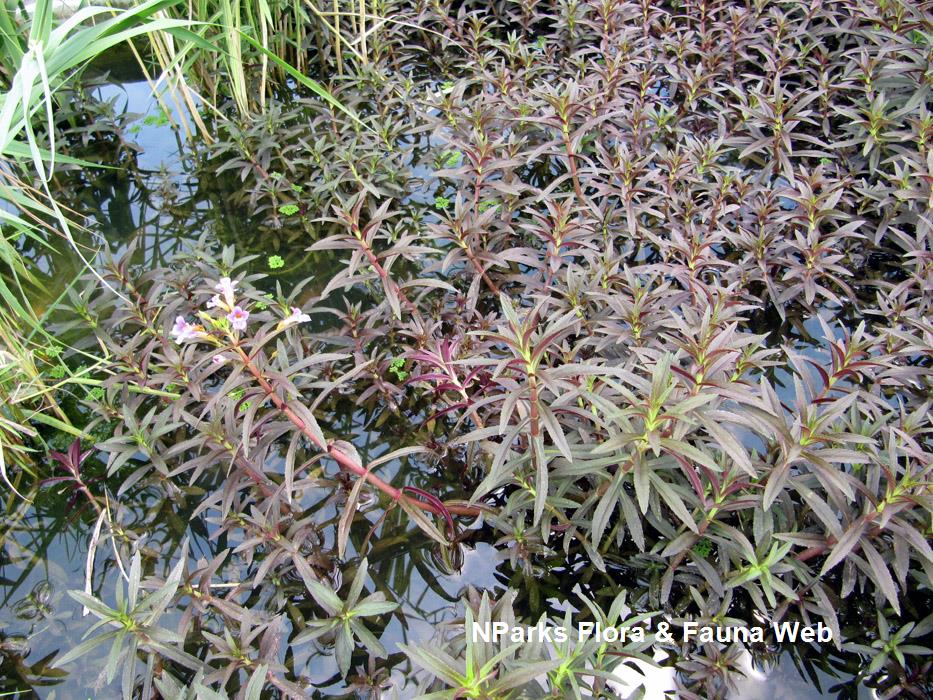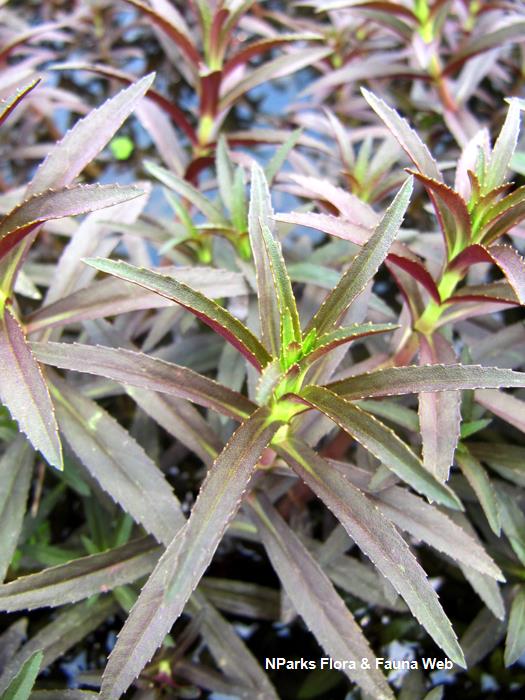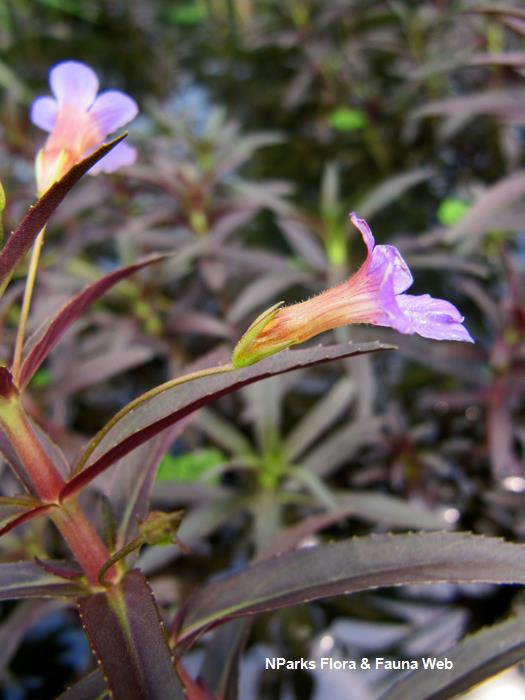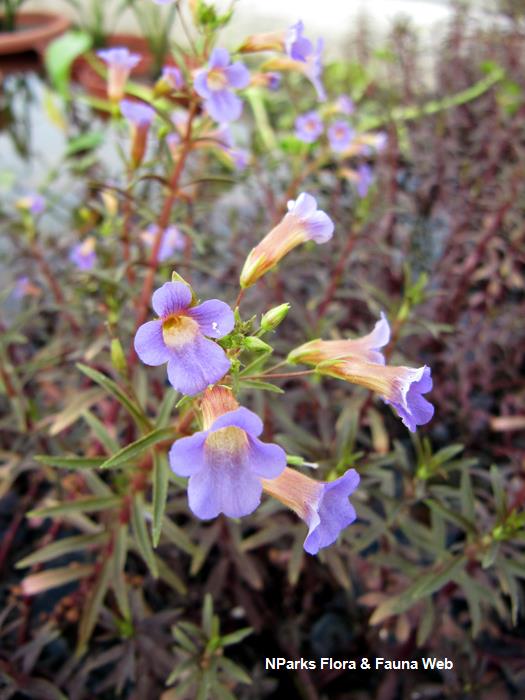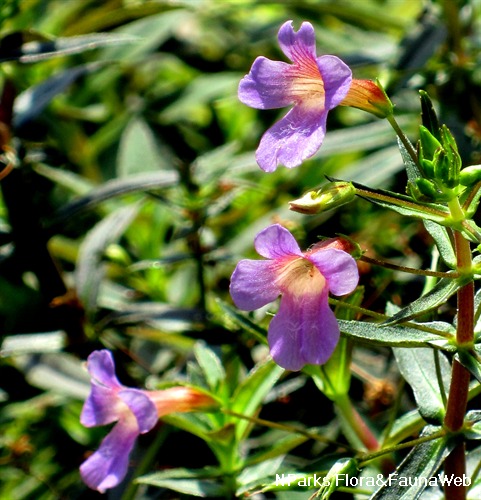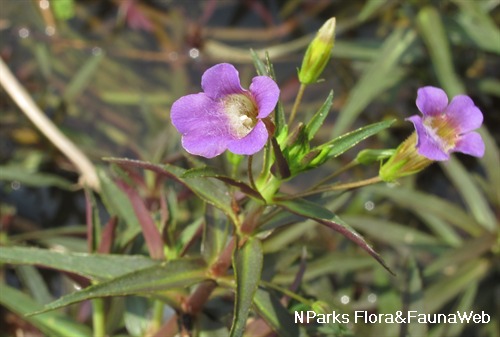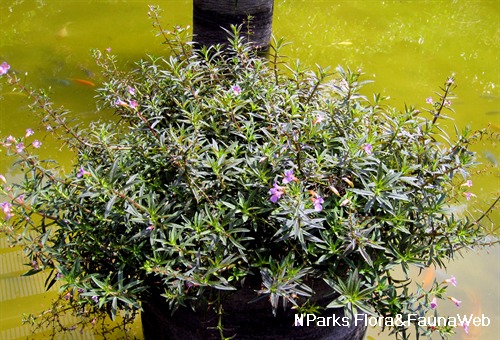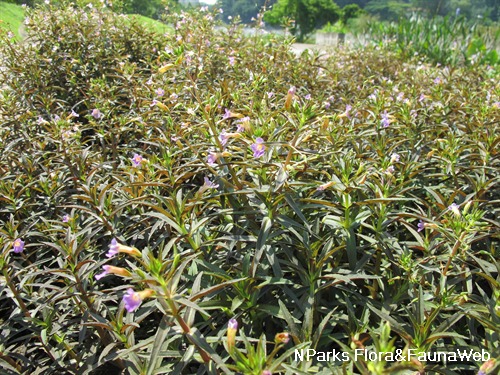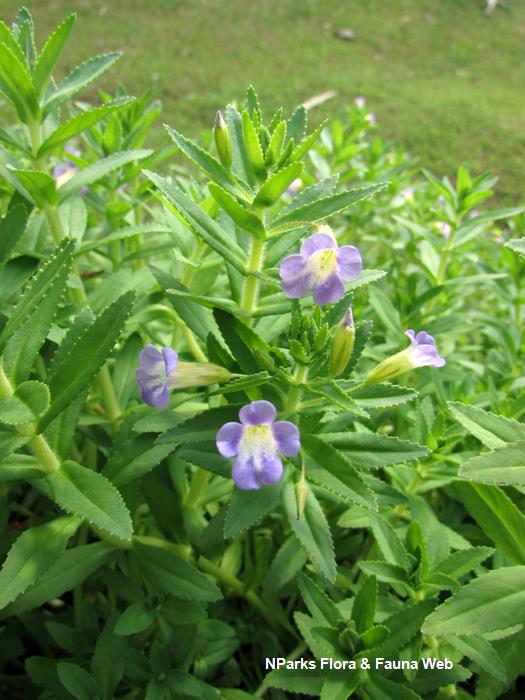
Back
Limnophila aromatica (Lam.) Merr.
| Family Name: | Plantaginaceae |
| Synonyms: | Limnophila aromaticoides |
| Common Name: | Rice Paddy Herb, 紫苏草, 水薄荷 |
Rice Paddy Herb is an aquatic herb that is used in Southeast Asia as a vegetable, herb and medicinal plant with lemon- and cumin-like flavours.
Name
Classifications and Characteristics
| Plant Division | Angiosperms (Flowering Seed Plants) (Dicotyledon) |
|---|---|
| Plant Growth Form | Aquatic & Hydrophyte (Emergent Aquatic, Submerged Aquatic), Herbaceous Plant |
| Lifespan (in Singapore) | Perennial |
| Mode of Nutrition | Autotrophic |
| Maximum Height | 30 cm to 100 cm |
Biogeography
| Native Distribution | Tropical and Subtropical Asia to Northern and Northeastern Australia |
|---|---|
| Native Habitat | Aquatic (Freshwater Pond / Lake / River) |
| Preferred Climate Zone | Tropical |
Description and Ethnobotany
| Growth Form | An aquatic herbaceous plant with emergent and submerged forms. |
|---|---|
| Foliage | The simple leaves are arranged on the stem in opposite pairs or in whorls of 3. They are lanceolate-elliptic to ovate-lanceolate in shape. The leaf margin is toothed with rounded or pointed teeth. The submerged leaf form is less rigid and bigger in size as compared to the emergent leaf form. The leaves are green with a purple underside, under high light conditions, the submerged leaves turn red. |
| Stems | The stems are 30 to 100 cm in length and root at the nodes. The stems of the emergent form is purple in colour. |
| Flowers | The bluish purple, white or pink, tubular flowers (10.5 to 13.5 mm long) are only produced when the plant is above the water surface. They may be solitary in the leaf axils or in terminal or axillary raceme inflorescences up to 15 cm long. |
| Fruit | Fruit is a brown, egg-shaped to ellipsoid and compressed capsule (5 to 6 mm long). |
| Habitat | It is found in shallow ponds, rice paddy fields, marshes and reservoirs at altitudes of up to 1000 m. |
| Cultivation | It is best grown under full sun in consistently moist, fertile soil. For emersed plants, plenty of light, a water temperature of 20 to 25°C and pH level of 6.4 to 7.0 are ideal. Trim the stems regularly to prevent them from reaching the water surface. It is easy-to-grow, fast-growing and well-suited as a background or mid-ground plant in an aquarium. The stem tops can be used to propagate new plants. |
| Etymology | The genus 'Limnophila' originates from the Greek words for being related to lakes or fresh water ('limne') and loving something ('philos'). |
| Ethnobotanical Uses | Edible Plant Parts : Edible Leaves Food (Herb or Spice): It is used as a culinary herb in Vietnamese cuisine for its lemon and cumin-like flavour <3>. (Fruit or Vegetable): In Vietnam, Malaysia and Thailand, the plant is taken raw or cooked as a vegetable and used in salads, soups and curries <3>. Medicinal: Scientific Evidence of Medicinal Properties Based on research on the effect of Rice Paddy Herb on animals, it has vascular protective activity <1>. A study of healthy human volunteers who inhaled the essential oil aroma showed beneficial effects on mood and relaxation <3>. Traditional Medicinal Uses
In Peninsular Malaysia and Indonesia, leaf sap is used to clean wounds, while leaf decotion is used to treat fever <2>. This use is supported by research that showed the plant contains antimicrobial compounds and antioxidants <1>. |
Landscaping Features
| Desirable Plant Features | Ornamental Flowers, Ornamental Foliage |
|---|---|
| Landscape Uses | Parks & Gardens, Pond / Lake / River, Aquarium / Aquascape |
| Thematic Landscaping | Water Garden, Economic Garden |
Plant Care and Propagation
| Light Preference | Full Sun, Semi-Shade |
|---|---|
| Water Preference | Lots of Water |
| Plant Growth Rate | Fast |
| Rootzone Tolerance | Moist Soils, Waterlogged Soils (Does not Drain Site), Fertile Loamy Soils |
| Propagation Method | Seed, Stem Cutting (Herbaceous) |
Foliar
| Foliage Retention | Evergreen |
|---|---|
| Mature Foliage Colour(s) | Green |
| Foliar Type | Simple / Unifoliate |
| Foliar Arrangement Along Stem | Opposite, Whorled |
| Foliar Attachment to Stem | Sessile |
| Foliar Shape(s) | Non-Palm Foliage (Lanceolate, Elliptical, Ovate) |
| Foliar Venation | Pinnate / Net |
| Foliar Margin | Serrate / Toothed, Crenate |
| Foliar Apex - Tip | Acute |
| Typical Foliar Area | Microphyll ( 2.25cm2 - 20.25 cm2 ) |
| Typical Foliar Size | 1 cm to 5 cm |
Floral (Angiosperm)
| Flower Colour(s) | Purple, Blue, White, Pink |
|---|---|
| Flower Grouping | Solitary, Cluster / Inflorescence |
| Flower Location | Axillary, Terminal |
| Flower Symmetry | Bilateral |
| Individual Flower Shape | Funnelform / Funnel-shaped |
| Flower Size | 1.3 cm |
Fruit, Seed and Spore
| Fruit Type | Dehiscent Dry Fruit , Capsule |
References
| References | <1> Kukongviriyapan, U., Luangaram, S., Leekhaosoong, K., Kukongviriyapan, P., Preeprame, S. (2007). Antioxidant and Vascular Protective Activities of Cratoxylum formosum, Syzygium gratum and Limnophila aromatica. Biol. Pharm. Bull. 30(4): 661-666. <2> Schmelzer, G.H. (2001). Limnophila aromatica (Lamk) Merr.. In: van Valkenburg, J.L.C.H. and Bunyapraphatsara, N. (Editors): Plant Resources of South-East Asia No 12(2): Medicinal and poisonous plants 2. PROSEA Foundation, Bogor, Indonesia. <3> Thanatuskitti, P. , Siripornpanich, V. , Sayorwan, W. , Palanuvej, C. and Ruangrungsi, N. (2020). The Effects of Inhaled Limnophila aromatica Essential Oil on Brain Wave Activities and Emotional States in Healthy Volunteers: a Randomized Crossover Study. Res. J. of Pharma. 7(4): 1-9. |
|---|
Image Repository
Others
| Master ID | 31262 |
|---|---|
| Species ID | 5657 |
| Flora Disclaimer | The information in this website has been compiled from reliable sources, such as reference works on medicinal plants. It is not a substitute for medical advice or treatment and NParks does not purport to provide any medical advice. Readers should always consult his/her physician before using or consuming a plant for medicinal purposes. |

